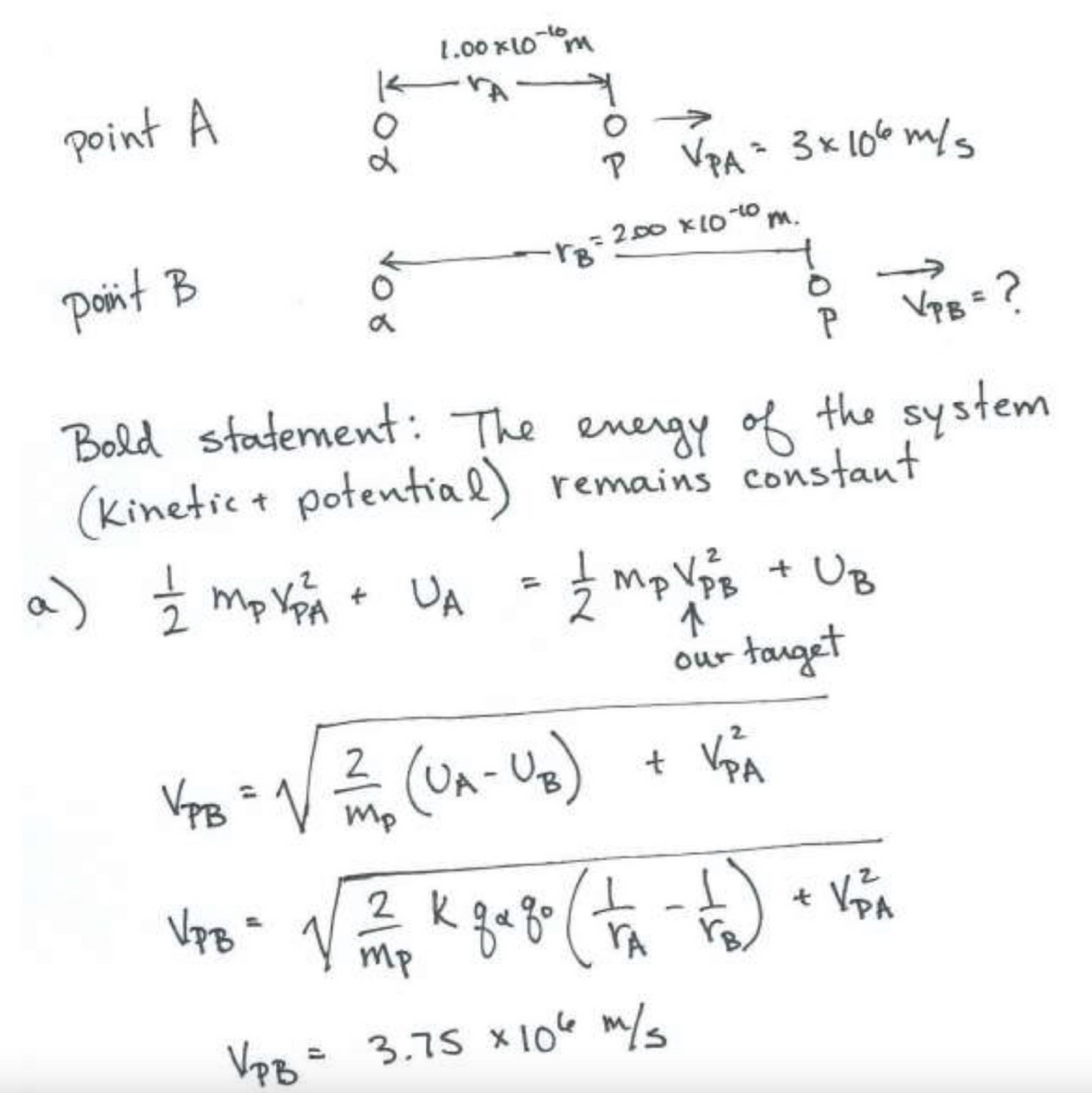A positron (the antiparticle of the electron) has the same mass as an electron (9.11×10-³¹ kg) but the opposite charge, +e +1.602×10-¹⁹ C. Suppose a positror moves in the vicinity of an alpha particle, which has a charge +2e = 3.204×10-¹⁹ C. The alpha particle is over 7000 times as massive as the positron, so we assume that it is at rest in some inertial frame of reference. When the positron is 1.00×10-¹⁰ m from the alpha particle, it is moving directly away from the alpha particle at a speed of 3.00×106 m/s. = a) What is the positron's speed when the two particles are 2.00×10-¹0 m apart? b) What is the positron's speed when it is very far away from the alpha particle? c) Repeat a) after replacing the positron with an electron.
A positron (the antiparticle of the electron) has the same mass as an electron (9.11×10-³¹ kg) but the opposite charge, +e +1.602×10-¹⁹ C. Suppose a positror moves in the vicinity of an alpha particle, which has a charge +2e = 3.204×10-¹⁹ C. The alpha particle is over 7000 times as massive as the positron, so we assume that it is at rest in some inertial frame of reference. When the positron is 1.00×10-¹⁰ m from the alpha particle, it is moving directly away from the alpha particle at a speed of 3.00×106 m/s. = a) What is the positron's speed when the two particles are 2.00×10-¹0 m apart? b) What is the positron's speed when it is very far away from the alpha particle? c) Repeat a) after replacing the positron with an electron.
College Physics
11th Edition
ISBN:9781305952300
Author:Raymond A. Serway, Chris Vuille
Publisher:Raymond A. Serway, Chris Vuille
Chapter1: Units, Trigonometry. And Vectors
Section: Chapter Questions
Problem 1CQ: Estimate the order of magnitude of the length, in meters, of each of the following; (a) a mouse, (b)...
Related questions
Question

Transcribed Image Text:has the
3. A positron (the antiparticle of the electron)
same mass as an electron
(9.11×10-³¹ kg) but the opposite charge, +e
= +1.602×10-¹9 C. Suppose a positror
moves in the vicinity of an alpha particle,
which has a charge +2e = 3.204×10-¹⁹ C.
The alpha particle is over 7000 times as
massive as the positron, so we assume that
it is at rest in some inertial frame of
reference. When the positron is 1.00×10-¹⁰
m from the alpha particle, it is moving
directly away from the alpha particle at a
speed of 3.00×10⁰ m/s.
a) What is the positron's speed when the
two particles are 2.00×10-¹0 m apart?
b) What is the positron's speed when it is
very far away from the alpha particle?
c) Repeat a) after replacing the positron
with an electron.
d) Repeat b) after replacing the positron
with an electron. The result here tells
you whether the electron will
eventually turn around and head
toward the alpha particle. Will the
electron turn around? If so, at what
distance away does it turn around (i.e.,
momentarily come to rest)? If not,
why?
Expert Solution
Step 1

Trending now
This is a popular solution!
Step by step
Solved in 2 steps with 2 images

Knowledge Booster
Learn more about
Need a deep-dive on the concept behind this application? Look no further. Learn more about this topic, physics and related others by exploring similar questions and additional content below.Recommended textbooks for you

College Physics
Physics
ISBN:
9781305952300
Author:
Raymond A. Serway, Chris Vuille
Publisher:
Cengage Learning

University Physics (14th Edition)
Physics
ISBN:
9780133969290
Author:
Hugh D. Young, Roger A. Freedman
Publisher:
PEARSON

Introduction To Quantum Mechanics
Physics
ISBN:
9781107189638
Author:
Griffiths, David J., Schroeter, Darrell F.
Publisher:
Cambridge University Press

College Physics
Physics
ISBN:
9781305952300
Author:
Raymond A. Serway, Chris Vuille
Publisher:
Cengage Learning

University Physics (14th Edition)
Physics
ISBN:
9780133969290
Author:
Hugh D. Young, Roger A. Freedman
Publisher:
PEARSON

Introduction To Quantum Mechanics
Physics
ISBN:
9781107189638
Author:
Griffiths, David J., Schroeter, Darrell F.
Publisher:
Cambridge University Press

Physics for Scientists and Engineers
Physics
ISBN:
9781337553278
Author:
Raymond A. Serway, John W. Jewett
Publisher:
Cengage Learning

Lecture- Tutorials for Introductory Astronomy
Physics
ISBN:
9780321820464
Author:
Edward E. Prather, Tim P. Slater, Jeff P. Adams, Gina Brissenden
Publisher:
Addison-Wesley

College Physics: A Strategic Approach (4th Editio…
Physics
ISBN:
9780134609034
Author:
Randall D. Knight (Professor Emeritus), Brian Jones, Stuart Field
Publisher:
PEARSON